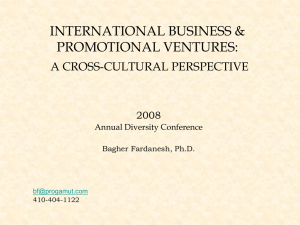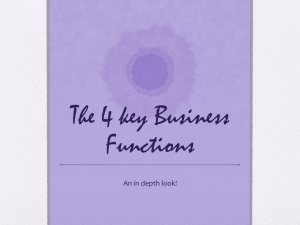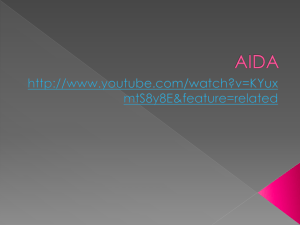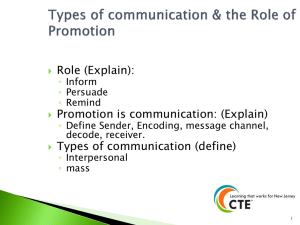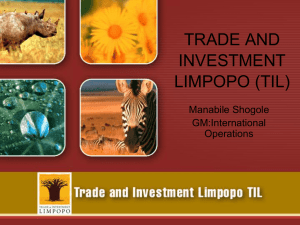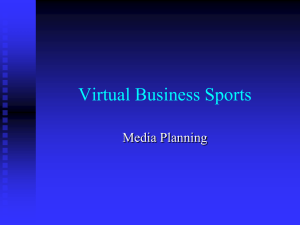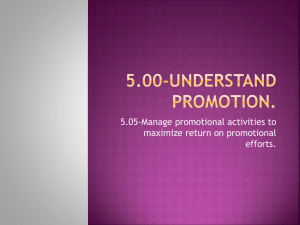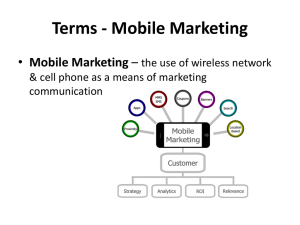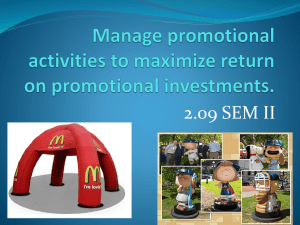Promotional mix
advertisement
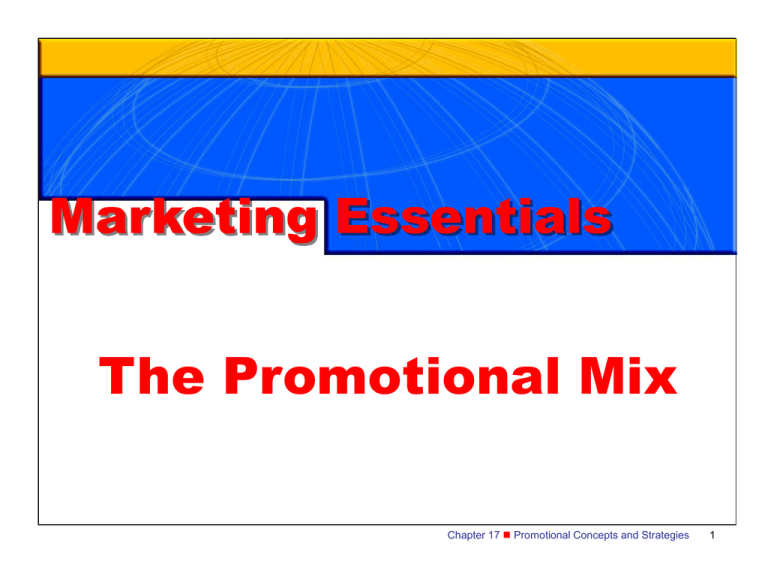
Marketing Essentials The Promotional Mix Chapter 17 n Promotional Concepts and Strategies 1 SECTION 17.1 The Promotional Mix What You'll Learn The role of promotion in marketing in the marketing mix The concept of promotional mix The characteristics of personal selling and advertising The communication process The nature and scope of publicity Chapter 17 n Promotional Concepts and Strategies 2 SECTION 17.1 The Promotional Mix Why It's Important Since businesses must continually promote their organizations, products, and policies to gain customer acceptance, you will need to learn successful promotional strategies. Chapter 17 n Promotional Concepts and Strategies 3 SECTION 17.1 The Promotional Mix Key Terms promotion sales promotion promotional mix public relations product promotion communication institutional promotion publicity advertising push policy pull policy Chapter 17 n Promotional Concepts and Strategies 4 SECTION 17.1 The Promotional Mix -VSChapter 17 n Promotional Concepts and Strategies 5 SECTION 17.1 The Promotional Mix The Concept of the Promotional Mix Promotion is any form of communication a business or organization uses to inform, persuade, or remind people about its products. Promotional mix is a combination of the different types of promotion. A business decides on the promotional mix that will be most effective in persuading potential customers to purchase its products. Slide 1 of 2 Chapter 17 n Promotional Concepts and Strategies 6 SECTION 17.1 The Promotional Mix The Role of Promotion in the Marketing Mix Overall Marketing Objectives • • • • Marketing Mix Product Place Promotion Price Target Market Slide 1 of 2 Promotional Mix • • • • Advertising Public Relations Sales Promotion Personal Selling Promotion Plan Chapter 17 n Promotional Concepts and Strategies 7 SECTION 17.1 Competitive Advantage The main function of a marketer’s promotional strategy is to convince the target market that the goods and services offered provide a competitive advantage. High product quality Rapid delivery Low prices Excellent service Unique features Chapter 17 n Promotional Concepts and Strategies 8 SECTION 17.1 The Promotional Mix The Concept of the Promotional Mix A business uses product promotion to convince potential customers to buy its products instead of buying from a competitor. Institutional promotion is used by businesses to create a favorable image for themselves, as opposed to promoting specific products or services. Slide 2 of 2 Chapter 17 n Promotional Concepts and Strategies 9 SECTION 17.1 The Promotional Mix Types of Promotion There are four basic types of promotion: personal selling advertising sales promotion public relations Slide 1 of 4 Chapter 17 n Promotional Concepts and Strategies 10 SECTION 17.1 The Promotional Mix Planned presentation to one or more prospective buyers for the purpose of making a sale. Slide 1 of 4 Chapter 17 n Promotional Concepts and Strategies 11 SECTION 17.1 The Promotional Mix Most commonly distributed by traditional media, though increasingly through nontraditional media, such as Web sites, e-mail, and blogs. Slide 1 of 4 Chapter 17 n Promotional Concepts and Strategies 12 SECTION 17.1 The Promotional Mix Advertising Media Traditional Advertising Media Television Radio Newspapers Magazines Books Direct mail Billboards Transit cards Slide 1 of 4 New Advertising Media Internet Banner ads Viral marketing E- mail Interactive video Chapter 17 n Promotional Concepts and Strategies 13 SECTION 17.1 The Promotional Mix Advertising Advantages Reach large number of people Low cost per contact Can be microtargeted Slide 1 of 4 Disadvantages Total cost is high National reach is expensive for small companies Chapter 17 n Promotional Concepts and Strategies 14 SECTION 17.1 The Promotional Mix Marketing activities—other than personal selling, advertising, and public relations—that stimulate consumer buying and dealer effectiveness Slide 1 of 4 Chapter 17 n Promotional Concepts and Strategies 15 SECTION 17.1 The Promotional Mix Helps an organization communicate with customers, suppliers, stockholders, government officials, employees, and the community . Slide 1 of 4 Chapter 17 n Promotional Concepts and Strategies 16 SECTION 17.1 The Promotional Mix Types of Promotion Publicity is a specific kind of public relations that involves placing positive newsworthy information about a business in the media. Publicity is much cheaper than advertising, and a mention on the news is more likely to be regarded as objective. On the other hand, companies cannot control negative publicity. Slide4 of 4 Chapter 17 n Promotional Concepts and Strategies 17 SECTION 17.1 The Promotional Mix Coordination of the Promotional Mix Most businesses use more than one type of promotion to achieve their promotional goals. Each type of promotion is designed to complement one another, and all must be coordinated. Chapter 17 n Promotional Concepts and Strategies 18 SECTION 17.1 Marketing Communication Communication The process by which meanings are exchanged or shared through a common set of symbols. Chapter 17 n Promotional Concepts and Strategies 19 SECTION 17.1 Marketing Communication The Communication Process Noise Sender Encoding Message Message Channel Decoding Message Receiver Feedback Channel Chapter 17 n Promotional Concepts and Strategies 20 SECTION 17.1 The Goals of Promotion • Attention • Interest • Desire • Action Chapter 17 n Promotional Concepts and Strategies 21 SECTION 17.1 The Promotional Mix Promotional Budget In large companies, the marketing department establishes a promotion budget, allocates resources, coordinates the campaign, and determines the right promotional mix for the company. In smaller businesses, these responsibilities often rest with the owner-operator, are divided among employees, or contracted to outside agencies. Chapter 17 n Promotional Concepts and Strategies 22 SECTION 17.1 The Promotional Mix The Push-Pull Concept A push policy is used to convince a retailer to stock the products being promoted, pushing the product to the retailer. A push strategy relies heavily on personal selling and promotion at trade shows. A pull policy is designed to create consumer interest, pulling consumers to the product. Chapter 17 n Promotional Concepts and Strategies 23 17.1 ASSESSMENT Reviewing Key Terms and Concepts 1. What is promotion? 2. Describe the concept of promotional mix. 3. What is the difference between product and institutional promotion? 4. Why is personal selling the most expensive form of promotion? 5. What is the difference between publicity and advertising? Chapter 17 n Promotional Concepts and Strategies 24 17.1 ASSESSMENT Thinking Critically Java Jacket is a company that designs and prints ads on the paper jackets that go around hot coffee cups sold in coffee shops. To find clients to advertise on the coffee cup jackets, the company sent a representative to companies like Warner Brothers, eBay.com, and the Wall Street Journal to tell them how their ads on coffee cup jackets would give them inexpensive exposure to a large number of potential customers. Java Jacket’s activities can best be described as: Personal Selling Chapter 17 n Promotional Concepts and Strategies 25 17.1 Graphic Organizer Elements of the Promotional Mix Personal Selling Advertising Sales Promotion Public Relations Chapter 17 n Promotional Concepts and Strategies 26 Integrating Academic Skills: Homework COMMUNICATION Find 3 stories about local or national companies online. Identify each company and then categorize the publicity in the article as either positive or negative. Support your conclusion in each case with a paragraph or two explaining what the facts are and how the publicity may help or harm the business. Chapter 17 n Promotional Concepts and Strategies 27 Marketing Essentials Sales Promotion Chapter 17 n Promotional Concepts and Strategies 28 SECTION 17.2 Sales Promotion What You'll Learn The characteristics of sales promotion The concept of trade promotions The different kinds of consumer sales promotions Chapter 17 n Promotional Concepts and Strategies 29 SECTION 17.2 Sales Promotion Why It's Important To be successful, a business must continually promote its products. This section introduces you to the concept of sales promotion and the techniques used to increase sales and to inform customers about a company’s products. Chapter 17 n Promotional Concepts and Strategies 30 SECTION 17.2 Sales Promotion Key Terms slotting allowance sales incentives premiums incentives licensing promotional tie-ins Chapter 17 n Promotional Concepts and Strategies 31 SECTION 17.2 Sales Promotion Sales Promotion Sales promotion is a short-term incentive offered to encourage buying a good or service. Sales promotions can be directed toward manufacturers, wholesalers, retailers, and consumers, as well as a company's employees. Sales promotions are usually supported by advertising activities. Chapter 17 n Promotional Concepts and Strategies 32 SECTION 17.2 Sales Promotion Trade Promotions Trade promotions are sales promotion activities designed to gain manufacturers', wholesalers', and retailers' support for a product. More money is actually spent on promoting to businesses than to consumers. Major trade promotions include: slotting allowances buying allowances trade shows and conventions sales incentives Slide 1 of 3 Chapter 17 n Promotional Concepts and Strategies 33 SECTION 17.2 Sales Promotion Trade Promotions Slotting allowances are cash premiums paid by the manufacturer to a retail chain for the costs involved in placing a new product on its shelves. Buying allowances are price discounts given by manufacturers to wholesalers and retailers to encourage the purchase of a product. Slide 2 of 3 Chapter 17 n Promotional Concepts and Strategies 34 SECTION 17.2 Sales Promotion Trade Promotions Trade shows and conventions are events at which businesses can introduce new products, encourage increased sales of existing products, and gain continued company and product support. Sales incentives are awards given to managers and employees who successfully meet or exceed sales quotas. Slide3 of 3 Chapter 17 n Promotional Concepts and Strategies 35 SECTION 17.2 Sales Promotion Consumer Sales Promotions Sales promotion efforts designed to encourage customers to buy a product are called consumer promotions. They include: premiums incentives product samples loyalty marketing programs promotional tie-ins product placement visual merchandising and displays Chapter 17 n Promotional Concepts and Strategies 36 SECTION 17.2 Sales Promotion Premiums Premiums are an extra item offered to the consumer, usually in exchange for some proof of purchase of the promoted product. One example: McDonald’s Happy Meal, which rewards children with a toy. Slide 1 of 3 Chapter 17 n Promotional Concepts and Strategies 37 SECTION 17.2 Sales Promotion Premiums Coupons are certificates that entitle customers to cash discounts on goods or services. Factory packs are free gifts placed in product packages. These are common in cereal boxes. Slide 2 of 3 Chapter 17 n Promotional Concepts and Strategies 38 SECTION 17.2 Sales Promotion Premiums Traffic builders are low-cost premiums such as pens or key chains given away free to consumers for visiting a new store or attending an event. Coupon plans are ongoing programs offering a variety of premiums in exchange for labels, coupons, or other tokens. Slide 3 of 3 Chapter 17 n Promotional Concepts and Strategies 39 SECTION 17.2 Sales Promotion Incentives Incentives generally are higherpriced products earned and given through contests (games of skill), sweepstakes (games of chance), and rebates (discounts from manufacturers). Businesses use incentives to promote many products because they create customer excitement and increase sales. Chapter 17 n Promotional Concepts and Strategies 40 SECTION 17.2 Sales Promotion Product Samples A product sample is a free trial size of a product sent through the mail, distributed door-todoor, or given away at retail stores and trade shows. Detergents, toothpastes, shampoos, deodorants, and colognes are frequently promoted this way. Chapter 17 n Promotional Concepts and Strategies 41 SECTION 17.2 Sales Promotion Promotional Tie-Ins Promotional tie-ins involve coordinated sales promotional arrangements between one or more retailers or manufacturers. Example: For the promotion of the Shrek movie, Disney Studios cooperated with McDonald's which made a special Happy Meal with a Shrek toy. Chapter 17 n Promotional Concepts and Strategies 42 SECTION 17.2 Sales Promotion Loyalty Marketing Programs Loyalty marketing programs, also called frequent buyer programs, reward customers for making multiple purchases. Loyalty marketing was popularized in the 1980s by the airline industry, which instituted frequent flier programs. Chapter 17 n Promotional Concepts and Strategies 43 SECTION 17.2 Sales Promotion Product Placement With product placement, an organization can develop product recognition by making sure that a product is featured in special events, on television, or in the movies. Example: Apple's iMac appeared in popular television shows when it was first introduced. Chapter 17 n Promotional Concepts and Strategies 44 SECTION 17.2 Sales Promotion Visual Merchandising and Displays Visual merchandising refers to the coordination of all physical elements in a place of business so that it projects the right image to its customers. Displays refer to the visual and artistic aspects of presenting a product to a target group of customers. Chapter 17 n Promotional Concepts and Strategies 45 SECTION 17.2 Sales Promotion Point-of-Purchase Promotion (P-O-P) display is a promotional display set up at the retailer’s location to build traffic, advertise the product, or induce impulse buying. These include: shelf “talkers”, shelf extenders, ads on carts and bags, end-aisle and floor-stand displays, TV monitors and in-store messages, and audiovisual displays. Chapter 17 n Promotional Concepts and Strategies 46 17.2 A SSESSMENT Reviewing Key Terms and Concepts 1. Why do businesses use sales promotions? 2. What unique characteristics do sales promotions have? 3. What are trade promotions? 4. What are consumer promotions? 5. Explain the difference between a sweepstakes and a contest. Chapter 17 n Promotional Concepts and Strategies 47 17.2 A SSESSMENT Thinking Critically Consumers who send it 10 UPC symbols as proof of purchase of Chip Ahoy cookies will receive a children’s classic DVD. The DVD is an example of a: Premium Chapter 17 n Promotional Concepts and Strategies 48
